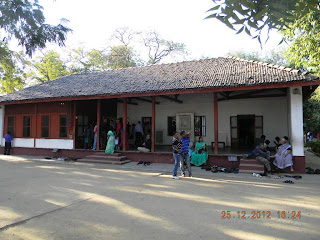Ahmedabad
is the 6th largest city and a commercial hub of the state of
Gujarat. Although, it is not a very well
known ‘tourist’ destination, it is certainly worth a visit. Two friends joined us with their motorbikes
and offered to show us around the city.
After having a typical Gujarati breakfast of snacks and chutney, our
group of 4 members reached the famous ISKCON temple. This temple is dedicated to Lord Krishna and
his consort Radha and is one of the most beautiful temples in the city. The interiors of the temple were adorned with
paintings and sculptures depicting important scenes from mythology. The sanctum
sanctorum was very quiet and had marble deities of the Gods. The temple with its calm and peaceful
atmosphere offers the perfect spot to spend some quiet time with oneself.
After
our worship, we proceeded towards Adalaj, a village located close to Gandhi
Nagar, the capital of Gujarat. A
stepwell named Adalaj Ka Vav is a unique Hindu water building in the village of
Adalaj. This stepwell was built in 1499
by a Muslim King for his wife. There is
no entrance fee for visiting the stepwell.
We observed scores of school students who had come to visit the well as a
part of excursion from school.
Built
in sand stone in Indo-Islamic architectural style, the step well is five
stories deep. It is octagonal in plan at
the top and built on many intricately carved pillars. Each floor is spacious
enough to provide for people to congregate.
It was dug deep to access ground water at that level. The pillars are carved with women performing
daily chores such as churning of buttermilk, adorning themselves, scenes of
performance of dancers and musicians etc.
The
temperature inside the well has been implied to be five degrees lower than the
outside temperature during hot summers.
We spent about an hour capturing photos of the well from various angles
and enjoying the intricate sculptures on the interior walls of the well.
Akshardham
is the most popular and one of the largest temples in Gandhi Nagar. The temple complex is spread over an area of
23 acres and combines devotion, art, architecture, education, exhibitions and
research at one place. The temple was
built by the BAPS, an international social, spiritual and charitable NGO
affiliated with the United Nations.
There
is a high level of security at the temple and one is not allowed to enter the
temple with any electronic item. There
are deposit lockers for mobile phones and camera. Slippers were deposited at a location just to
the right of the main shrine.
The
monument enshrining the 7-foot high gold leafed idol of Lord Swaminarayan is
the focal point of the complex. The
majestic stone structure is intricately carved and surrounded by sprawling
gardens. The garden is a unique blend of
contemplative garden and children’s park.
Recreation activities of varying kinds were made available for children
towards the left side in the main campus.
This included rides and games, a herbal garden, a lake and a waterfall. On the right side of the main campus, there
was a book exhibition center and a restaurant.
Due to lack of time, we could not spend time at the cultural exhibitions
and displays depicted at halls around the main temple. After worship, we had a light lunch and left
the temple campus for Sabarmati ashram.
Gandhi
ashram, also called Sabarmati ashram, is located near Vadaj and was founded by
Mahatma Gandhi in 1915. It is today the
biggest tourist attraction in Ahmedabad and lies on the tranquil stretch of the
Sabarmati River. It was from here that
Mahatma began his famous Dandi March in 1930 to protest against the Salt Tax
imposed by the British regime.
The
ashram is an exhibition of Mahatma’s life, from his childhood to his
death. The rare portraits and photos
transform us to an earlier era and bring us close to the life of the ‘Father of
the Nation’. One can spend time by the
banks of the Sabarmati River and also visit the home of the Mahatma, which is
located in the same campus. The house
has a separate room for the Mahatma, his wife Kasturba, a room for guests, a
kitchen and a courtyard. We spent about
an hour and half at the tranquil calms of the ashram and then left for our
final destination of the day – river front of the Sabarmati.
River
front is a new addition to the attractions of Ahmedabad. A concrete pathway by the side of River
Sabarmati with seats to sit and enjoy the river is the place of interest for
many youngsters and elders alike. Many
people were taking routine walks and exercising to keep themselves fit. We spent an hour sitting by the river front
before we returned back to our accommodation.
Ahmedabad
is certainly a must visit for anyone who has Gujarat in his tourist calendar. The city with almost no power cuts, good water
supply, multiple places of interest, a structured Bus Rapid Transit system and
umpteen eatery options is surely a development model other cities must vie to acheive.








No comments:
Post a Comment